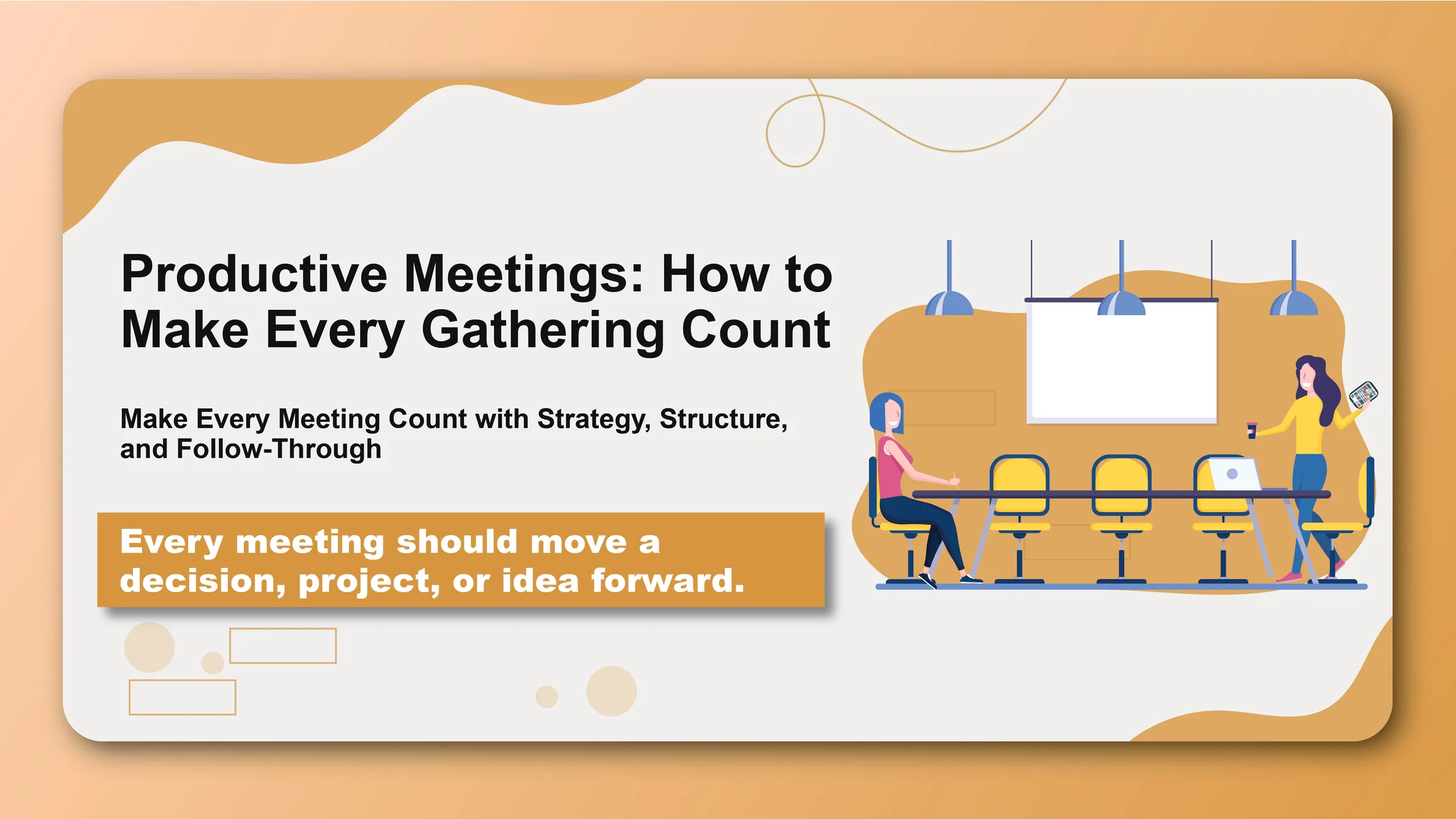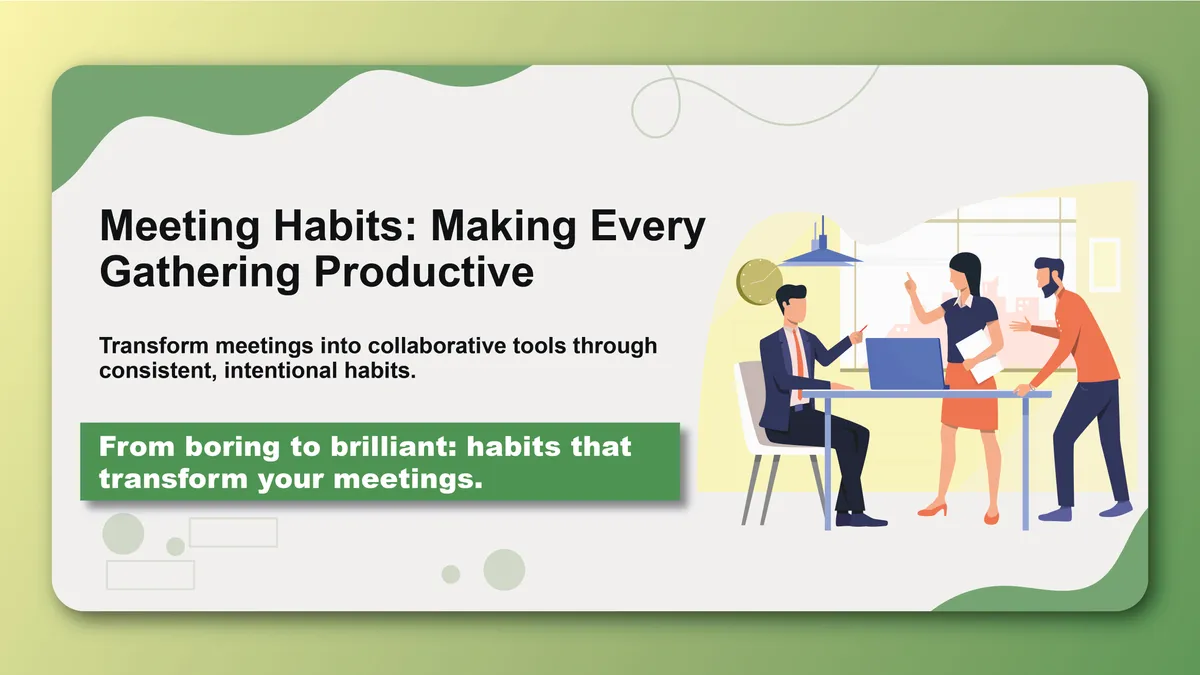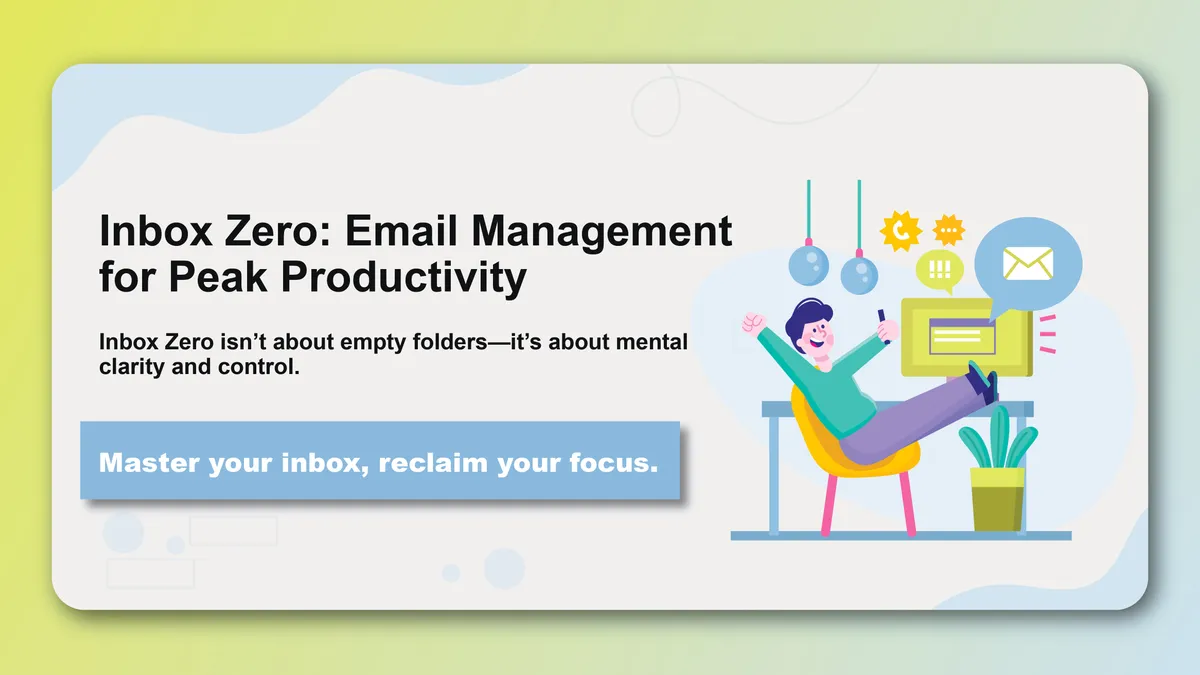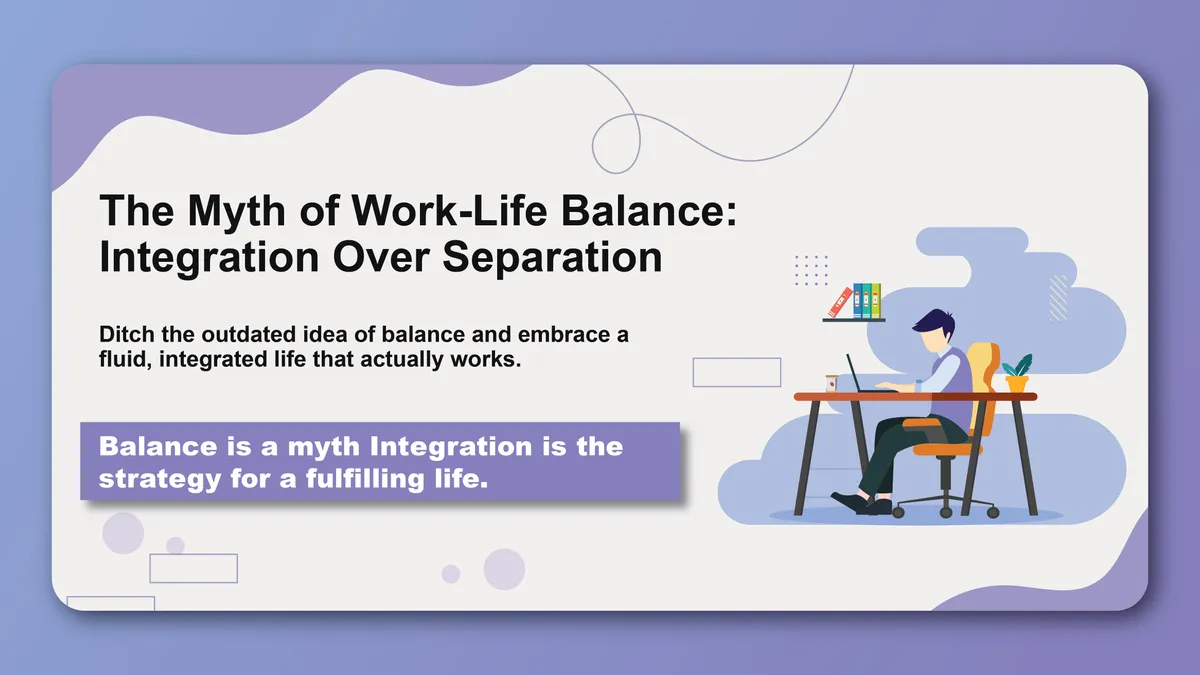"This meeting could have been an email."
If you've ever thought this during a meeting, you're not alone. The average knowledge worker spends 35-50% of their time in meetings, yet studies show that 67% of employees report spending too much time in meetings, and 64% say meetings prevent them from doing deep work.
But here's the thing: meetings aren't inherently bad. In fact, they're essential for collaboration, decision-making, and maintaining team cohesion. The problem isn't meetings themselves—it's how we conduct them.
When done right, meetings can be powerful catalysts for progress. They can accelerate decision-making, spark innovation, build relationships, and align teams around shared goals. The difference between a productive meeting and a time-waster often comes down to intentional design and skillful execution.
The question isn't whether to have meetings—it's how to make every gathering count.
The Cost of Bad Meetings
The Hidden Price Tag
Time Costs
- Average meeting costs: $338 per hour for 8 people
- 15 minutes of overrun × 4 people = 1 hour of lost productivity
- Preparation time often exceeds meeting time
- Context switching reduces post-meeting productivity
Opportunity Costs
- Deep work gets fragmented
- Creative thinking gets interrupted
- Individual productivity suffers
- Strategic projects get delayed
Morale Costs
- Meeting fatigue reduces engagement
- Poorly run meetings erode trust
- Wasted time creates frustration
- Bad meetings become cultural norms
Common Meeting Failures
Purpose Problems
- No clear objective
- Too many objectives
- Objectives that don't require a meeting
- Confusion about desired outcomes
People Problems
- Wrong people in the room
- Too many people involved
- Key people missing
- Unclear roles and responsibilities
Process Problems
- No agenda or poor agenda
- Inadequate preparation
- Lack of time management
- No clear next steps
The Anatomy of Productive Meetings
Before the Meeting: Preparation
The Purpose Test Before scheduling any meeting, ask:
- What specific outcome do we need to achieve?
- Could this be accomplished another way?
- What happens if we don't have this meeting?
- How will we know if the meeting was successful?
The Right People
- Decision Makers: People who can make the necessary decisions
- Information Holders: People with relevant knowledge or data
- Implementers: People who will execute the decisions
- Stakeholders: People significantly affected by the outcomes
The RACI Framework For each participant, clarify:
- Responsible: Who will do the work?
- Accountable: Who will ensure it gets done?
- Consulted: Who needs to provide input?
- Informed: Who needs to know the outcome?
During the Meeting: Execution
Start Strong
- Begin exactly on time
- Restate the purpose and desired outcomes
- Review the agenda and time allocations
- Set ground rules for participation
Manage Energy and Attention
- Keep most meetings to 25-50 minutes
- Use the "Rule of 7" - no more than 7 people for decision-making
- Encourage participation from quieter members
- Take breaks for longer meetings
Drive to Decisions
- Distinguish between information sharing and decision-making
- Use decision-making frameworks when needed
- Capture decisions clearly and immediately
- Identify next steps and owners
After the Meeting: Follow-up
Immediate Actions
- Send meeting notes within 24 hours
- Include decisions made and next steps
- Clarify deadlines and responsibilities
- Address any action items that emerged
Progress Tracking
- Schedule follow-up check-ins
- Track completion of action items
- Measure progress toward meeting objectives
- Gather feedback on meeting effectiveness
Meeting Types and Best Practices
Decision-Making Meetings
Structure for Success
- Frame the Decision: What exactly needs to be decided?
- Present Options: What are the viable alternatives?
- Analyze Criteria: What factors matter most?
- Make the Decision: Who decides, and how?
- Plan Implementation: What happens next?
Decision-Making Frameworks
- WRAP: Widen options, Reality-test assumptions, Attain distance, Prepare to be wrong
- Six Thinking Hats: Explore different perspectives systematically
- Pros and Cons: Simple but effective for straightforward decisions
- Weighted Scoring: Quantify criteria importance for complex decisions
Information Sharing Meetings
Maximize Value
- Share information in advance when possible
- Focus on interpretation and implications
- Encourage questions and discussion
- Provide context and background
- Use visual aids and storytelling
Engagement Strategies
- Ask specific questions about the information
- Request examples and applications
- Encourage connections to ongoing work
- Facilitate peer-to-peer learning
- Create opportunities for immediate application
Brainstorming Meetings
Generate Better Ideas
- Start with individual idea generation
- Build on others' ideas ("Yes, and...")
- Defer judgment during generation phase
- Strive for quantity over quality initially
- Use structured techniques like mind mapping
Avoid Common Pitfalls
- Don't let dominant personalities take over
- Separate idea generation from evaluation
- Don't settle for the first good idea
- Avoid groupthink and premature convergence
- Build on diverse perspectives
Problem-Solving Meetings
Structured Problem-Solving
- Define the Problem: What exactly is the issue?
- Analyze Root Causes: Why is this happening?
- Generate Solutions: What are our options?
- Evaluate Options: Which solutions are most viable?
- Create Action Plans: How will we implement?
Tools and Techniques
- 5 Whys: Drill down to root causes
- Fishbone Diagram: Identify contributing factors
- Force Field Analysis: Understand helping and hindering forces
- Solution Mapping: Visualize implementation steps
Digital Meeting Best Practices
Virtual Meeting Excellence
Technical Preparation
- Test technology before the meeting
- Have backup communication methods
- Ensure good lighting and audio
- Minimize background distractions
- Share screens and materials effectively
Engagement Strategies
- Use breakout rooms for small group discussions
- Leverage polling and chat features
- Encourage video participation
- Use collaborative tools like digital whiteboards
- Create opportunities for informal interaction
Hybrid Meeting Challenges
Inclusion Strategies
- Ensure remote participants can see and hear everything
- Rotate speaking opportunities fairly
- Use technology to level the playing field
- Create separate virtual and in-person discussion time
- Appoint a remote participant advocate
Communication Protocols
- Establish clear speaking and question protocols
- Use hand-raising features and visual cues
- Repeat questions and comments for everyone
- Share materials digitally with all participants
- Follow up with comprehensive meeting notes
Building a Meeting Culture
Organizational Standards
Meeting Principles
- Default to no meeting unless necessary
- Start and end on time
- Come prepared or don't come
- Participation is expected
- Decisions are made and documented
Meeting Policies
- No-meeting time blocks for deep work
- Maximum meeting lengths by type
- Required agenda circulation timeframes
- Meeting-free days or times
- Regular meeting effectiveness reviews
Personal Meeting Habits
As a Meeting Organizer
- Always have a clear purpose
- Invite only necessary participants
- Prepare and share agendas in advance
- Start and end on time
- Follow up consistently
As a Meeting Participant
- Prepare thoroughly before attending
- Participate actively and constructively
- Stay focused and present
- Contribute to decisions and discussions
- Follow through on commitments
Advanced Meeting Techniques
Meeting Design Thinking
Experience Design
- Consider the participant journey
- Design for specific outcomes
- Create engaging experiences
- Build in reflection and integration
- Measure and improve continuously
Facilitation Skills
- Master the art of asking questions
- Manage group dynamics effectively
- Keep discussions focused and productive
- Handle conflict and disagreement
- Create psychological safety
Meeting Innovation
New Meeting Formats
- Walking Meetings: For creative discussions
- Stand-up Meetings: For brief updates
- Silent Meetings: Start with individual reflection
- Fishbowl Discussions: For large group engagement
- World Café: For exploring multiple topics
Technology Integration
- Use AI meeting assistants for note-taking
- Implement real-time collaboration tools
- Leverage analytics for meeting improvement
- Use scheduling tools that respect time zones
- Integrate with project management systems
Measuring Meeting Success
Immediate Metrics
Effectiveness Indicators
- Meeting objectives achieved
- Decisions made and documented
- Action items identified and assigned
- Time used efficiently
- Participant engagement levels
Efficiency Measures
- Meeting started and ended on time
- All agenda items covered
- Appropriate participants present
- Good use of meeting time
- Clear next steps identified
Long-term Impact
Outcome Tracking
- Progress on action items
- Quality of decisions made
- Project advancement
- Team alignment improvement
- Problem resolution effectiveness
Cultural Indicators
- Meeting satisfaction scores
- Voluntary meeting attendance
- Meeting preparation quality
- Cross-functional collaboration
- Overall team productivity
Your Meeting Transformation Plan
Week 1: Assessment
- Track all meetings you attend or organize
- Evaluate each meeting's effectiveness
- Identify patterns and problems
- Gather feedback from colleagues
Week 2: Design
- Create meeting principles and standards
- Develop agenda templates
- Design follow-up processes
- Plan engagement strategies
Week 3: Implementation
- Apply new standards to upcoming meetings
- Practice facilitation techniques
- Experiment with new formats
- Gather feedback and adjust
Week 4: Optimization
- Review meeting effectiveness
- Refine processes based on feedback
- Share best practices with colleagues
- Plan for continued improvement
The Future of Meetings
Emerging Trends
AI-Enhanced Meetings
- Automated scheduling and agenda creation
- Real-time transcription and translation
- Meeting analytics and insights
- Predictive meeting success scoring
- Intelligent action item tracking
Immersive Technologies
- Virtual reality meeting spaces
- Augmented reality collaboration
- 3D visualization tools
- Haptic feedback systems
- Spatial audio for better presence
Cultural Evolution
Meeting Minimalism
- Intentional meeting reduction
- Asynchronous collaboration emphasis
- Deep work protection
- Quality over quantity focus
- Measurement and optimization
Inclusive Participation
- Accessibility-first design
- Cultural sensitivity awareness
- Diverse facilitation styles
- Multiple participation modes
- Equitable speaking opportunities
Productive meetings aren't about perfection—they're about intention. When you approach each meeting with clear purpose, thoughtful preparation, and skillful execution, you transform gatherings from time-wasters into value-creators.
The investment in better meetings pays dividends far beyond the meeting room. Teams make better decisions, projects move faster, relationships strengthen, and everyone's time becomes more valuable. Start with your next meeting, and begin building a culture where every gathering counts.
Ready to transform your meetings from time-wasters to value-creators? Plan and track your productive meetings with Habityzer and build systems that make every gathering count.



